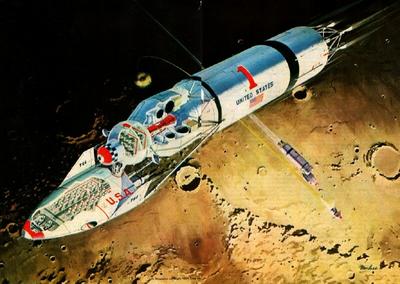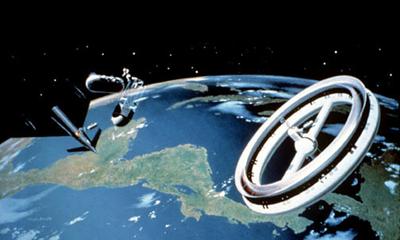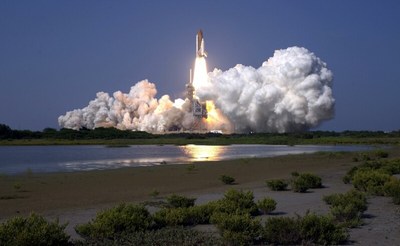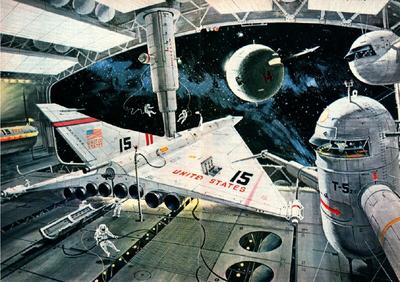Fifty years of piloted spaceflight: Where are we going?by Claude Lafleur
|
| In 1952 von Braun said, “ten to fifteen years from now, depending on how determinedly and efficiently we shall respond to this challenge, the Earth will have… the most fantastic laboratory ever devised.” |
As early as September 19511, Wernher von Braun, in a paper delivered to the Second International Congress on Astronautics, claimed that “a trip to Mars was entirely within the realm of possibility in present times.” He thus proposed the assembly of 10 giant interplanetary ships in Earth orbit with the use of 46 shuttle vehicles that would make 950 flights to haul components and propellants. Onboard these spaceships, 70 men would fly to Mars. “All that was needed, said von Braun, was to perfect the technique on establishing satellite way-stations in stable orbits around the Earth.” Other scientists, it was reported, agreed that this project presents no particular difficulty. Time for further research is necessary as well as, above all, money to finance the projects.
At the same meeting2, a space station model was presented by H. H. Koelle, a young German engineer. Weighing 150 tons and accommodating about fifty persons, this station would have the form of an outer ring that provided 38 cabins for living space and laboratories. Koelle said his design had the advantages of simplicity, lightness, and economy. The station would take about three months to assemble and costs $518 million in then-year dollars. “Only 1 per cent of the expenditure likely to be involved in a third world war would be needed to construct several space stations, build a Moon rocket and send an expedition to Mars,” he said.
In December 19513, another aeronautical engineer, Maj. Alexander de Seversky, claimed, “A new generation of American pioneers will be flying atomic-powered space ships to the Moon within the next fifty years… I am confident that interplanetary travel will be a reality before the end of the century.”
In the spring of 19524, three German engineers proposed a 510-ton outpost inhabited by 20 men and orbiting the Earth at an altitude of 680 kilometers. Building the station would take three years, cost half a billion dollars, and require 375 rocket flights. For his part, Wernher von Braun, in a lecture delivered at the Redstone Arsenal in Alabama, proposed to build a wheel-shaped station 75 metres in diameter, and placed at an altitude of 1,700 kilometers. “The technologists most competent to speak on the subject agree that the feat is possible, given time and money enough,” it was reported.
In a book called Across the Space Frontier published later that year5 von Braun described his station as “a practical launching site for interplanetary rockets and as a base to build a space observatory from which astronomers would studies the Universe.” The craft would be built by crewmembers in spacesuits using prefab sections. A dozen flights would be needed to complete the station. Von Braun added, “With a birds-eye view of air masses and clouds, observers on the station could predict next year’s weather more accurately than we now predict next month’s. They might even help maintain peace on Earth by scanning the continents, detecting large-scale military concentrations and threatening to blast the area with guided missiles carrying atomic explosives.”
At the second symposium on space travel held at the Hayden Planetarium, in October 19526, von Braun asserted that, “ten to fifteen years from now, depending on how determinedly and efficiently we shall respond to this challenge, the Earth will have… the most fantastic laboratory ever devised. It will also be the springboard to man's further ventures into outer space, to the moon and the nearer planets.”
 A lunar shuttle craft propelled by a nuclear rocket. I still pictured myself as a boy in the 1960s, dreaming that this will be my future! |
Flying low: what we have done
Of course, that’s not what had happened. In the last fifty years since Yuri Gagarin flew, an average of only six piloted spaceships a year were launched, carrying about 23 people overall per year and only ten new persons each year. Our International Space Station (in which six persons live and work) took ten years to build, by some 35 Space Shuttle crews, at a cost of about $100 billion.
The long and epic history of piloted spaceflight could be compared to the life span of a human being. First, there was the childhood era of spaceflight, a period full of adventures and dreams. Just as any child has to learn to walk, to speak, and to do some useful tasks (like tying his shoes), so was this period of courageous men pictured by Tom Wolfe’s The Right Stuff. This heroic period lasted about a dozen years, from Gagarin’s flight to the last lunar landing in 1972. During this interval, 46 missions took place, carrying 91 astronauts and cosmonauts (59 different persons). These were short-duration flights, averaging about a week: for example, Neil Armstrong spent only nine days in space during two missions, while making a two-and-a-half-hour walk on the Moon. Armstrong and his fellow explorers spent less time in space during their entire career than most of us spend each year on vacation!
| Now that assembly of the ISS is completed, we are entering a kind of “mature adulthood” of piloted spaceflight, a quiet life of occupancy of Earth orbit by three to six crewmembers. |
The second period, which lasted about 15 years—from Salyut 1 in 1971 to January 28,1986—was the “teenage era” of spaceflight. Onboard the first space stations, we learned how to establish ourselves into Earth orbit, hoping one day to go beyond. During this era, NASA was also developing the Space Shuttle, the multi-purpose truck designed to open the space frontier to settlement, business. and even tourism. As for any teenager, this was a time for intense dreams, such as 100-person space stations (or even Gerard O’Neill’s space colonies), numerous proposals to go to Mars, and—why not?—use the shuttle for tourist flights.
But this period ended abruptly on the morning of January 28, 1986, with the Challenger disaster. We thus entered “adulthood,” with the assembly of the Soviet Mir orbital complex and the first prolonged occupation of Earth orbit by two- or three-men crews. From 1987 to 1999, Mir was inhabited almost continuously by Russian cosmonauts. In the 1990s, the station received representatives from many nations, including Europe and the United States, and even some tourists. Thus, Mir became the first international space station.
During the same period, the Space Shuttle returned to flight, but with a very different purpose. It had become a transport ship mainly devoted to supporting space stations: first Mir, then ISS. There were no more talks of flying non-professional astronauts and no more propositions for industrial space development.
Now that assembly is completed, we are entering a kind of “mature adulthood” of piloted spaceflight, a quiet life of occupancy of Earth orbit by three to six crewmembers. Not thrilling, but an interesting period anyway. Of course, we still dream, but not of grandiose projects as we did in our teenage days of the 1970s.
We are even contemplating an “old age” period for spaceflight. Not only are we retiring the Space Shuttle—after 30 years of loyal services, as a good worker—but we are contemplating the end of the ISS program without any follow-on project. Are we approaching an era into which piloted spaceflight will be suspended?
Flying lessons: what we have learned
As any old man would tell everyone else, we have learned a lot during these fifty years of spaceflight. There are many lessons to be discussed: political, technological, societal, etc. But I will consider only two of them that are directly related to piloted spaceflight: our ability to live in space, and our inability to access space.
At the dawn of the spaceflight era, we were wondering if the human organism would be able to survive without Earth gravity. There were numerous discussions and theories debates among aerospace doctors and engineers.
But nobody foresaw that, in fact, human being would adapted itself very well to weightlessness—even too much! It takes only a couple of weeks to adapt to zero-g; the real problem is to keep the body fit to withstand Earth gravity upon return. In other words, if we should put a person in space for the rest of his life, there would be no need for him to do two hours of physical exercises every day, as all ISS crewmembers are required to do. It’s like as if our organism was fitted to live in space—a possibility that no one had envisioned fifty years ago.
More troubling, though, is our difficulty to access Earth orbit, even after decades of spaceflight. In the 1950s, science-fiction writers and rocket scientists expected that, by the 1970s or 1980s, spaceports would be as busy as airports, with winged shuttles regularly going back and forth from space. Going to space would be as routine as flying anywhere on Earth. Thus space would be opened to permanent occupation, commercial ventures, tourism flights, and lunar and planetary expeditions. But in reality, it is still very cumbersome to place a spaceship on Earth orbit. It’s still expensive, very risky and it demands months of preparation.
 Wernher von Braun’s famous orbital wheel with space shuttles and workers all around it. |
But getting into orbit is not the only obstacle, although it is the biggest one. While in orbit, assembly of large space structures has nothing to do with construction of buildings here on Earth. Decades ago, we envisioned construction workers, clad in space suits, assembling modules of gigantic wheel-shaped stations or planetary spaceships. Artists painted space cranes, workers on space-scooters, and winged shuttles working side-by-side around a construction space complex.
| We have good reasons to be proud of our achievements in space. But the space frontier proved to be far more daunting to conquer than any frontier here on Earth. |
But, in the 1960s, we discovered with awe that simply venturing out of a spacecraft for “walking in space” proved extremely difficult and risky. Even today, we still need to plan each EVA carefully months in advance. And only two spacewalkers go outside at a time for brief periods. So, there is no busy construction site in Earth orbit. Assembling the International Space Station proved to be so demanding and expensive that there will likely be no ISS-2. Our dreams of gigantic spaceships prepared to depart for the Moon or planets fade away as building any outpost is far beyond our capabilities.
What’s the problem… and the solution?
We have good reasons to be proud of our achievements in space. But the space frontier proved to be far more daunting to conquer than any frontier here on Earth. At the time of Gagarin’s flight, some observers compared this feat to Christopher Columbus’ first voyage. Gagarin was compared to Columbus himself, as was Neil Armstrong eight years later: they were the explorers of the “new ocean” of space.
Maybe it’s true. Maybe in a couple of centuries, our spaceships will be regarded as the sea ships of the 15th and 16th centuries. Maybe our cosmonauts and astronauts will be likened to Christopher Columbus, Amerigo Vespucci, Vasco da Gama, Ferdinand Magellan, and others of that era.
After all, considering our spaceflight, these challenges are not so different from the great expeditions across the ocean. Our little spaceships compared well to their sailboats. Our space explorers are as courageous as these mariners, risking their life to explore an ocean.
But we also know that, if these wooden ships opened up the sea and trans-oceanic travel, we had to wait some 300 years before we could efficiently navigate the oceans with engine-driven steel ships. It is these ships that really made possible the settlement of lands all around Earth and the routine maritime commerce between continents.
 Launching a rocket is setting off an explosion. Here is a 3,000-ton Space Shuttle “explosion,” a prodigious experience for anyone who had witnessed it. |
Launching a rocket is a unique experience. By igniting its engines at T-0, we literally spark an explosion—an explosion that must be controlled during nine minutes. If all goes well, those onboard the spaceship will achieve orbit at 28,000 km/h. But losing control of this explosion is generally fatal: one in twenty rockets, manned and unmanned, have failed!
A rocket is truly a dangerous machine. We can never test it completely before using it (as we do with any complex machine). It is built and checked carefully, but when its engines are ignited, we hope for the best. A rocket is the rare machine that is used only one time. In a sense, it is the most magnificent and inefficient machine ever developed!
Maybe in a couple of centuries, our descendents will developed a fundamentally different method for space transportation, with technology as different as the engine-driven steel ship is to the wooden sailboat. This will be this revolutionary spaceship that will give us access to the space ocean as the 19th century steel ships opened up sea travel and world economic development.
What kind of spaceship will it be? Could it be some kind of advanced aerospace plane, nuclear- or fusion-powered rocket, or even an exotic Earth-to-orbit elevator?
Probably not.
Picture ourselves at the time of Columbus. Who could have then been able to foresee an engine-driven steel ship? These concepts were out of reach even to the most fertile dreamer of that epoch.
It’s where we stand today in terms of space transportation technology. As Columbus, we use our state-of-the-art transportation to explore our ocean and to make possible for some courageous men and women to live and work onboard a little space station called ISS. But our technologies—especially the rocket—do not give us the opportunity to settle space. We’ll have to develop entire new concepts presently out of reach, and I pretend, our of our imagination.
In the meantime, we will continue to explore space with our modest means. For now, it looks like that, in the upcoming decades, it’s a possibility that we would virtually stop flying humans into space. Or, maybe, we will continue but at a slower pace. Maybe we will develop better rockets and spaceships (I hope so!) But, as long as we use rockets to “explode” up to Earth orbit, we will never be able to settle space as we once dreamed fifty years ago.
References:
- “Scientist Projects Journey To Mars”, The New York Times, September 7, 1951.
- “Briton Ridicules Space Ship In War”, The New York Times, September 8, 1951.
- “Atom Trip To Moon In 50 Years Is Seen”, The New York Times, December 8, 1951.
- “Editorial: Artificial Moon”, The New York Times, June 8, 1952.
- “A Man-Made Air Station 1,075 Miles Beyond the Earth”, The New York Times, October 5, 1952.
- “2 Rocket Experts Argue 'Moon' Plan”, The New York Times, October 14, 1952.
